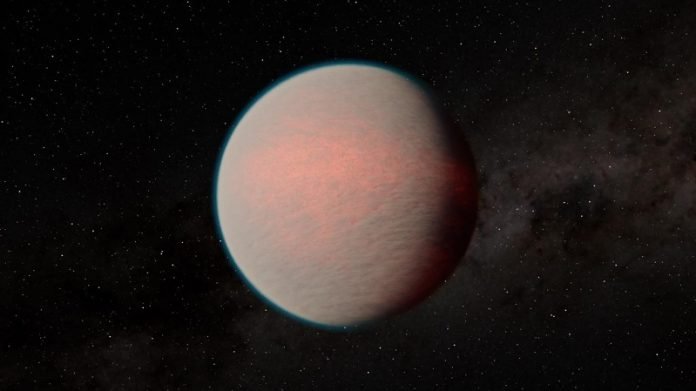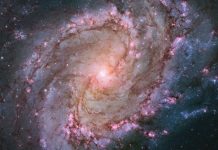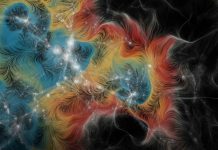
Exoplanet GJ 1214b is too hot to be habitable, but likely contains water vapor.
For more than a decade, astronomers have been trying to get a closer look at GJ 1214b, a planet 40 light-years away from Earth.
Their biggest obstacle is a thick layer of haze that blankets the exoplanet, shielding it from the probing eyes of telescopes and stymying efforts to study its atmosphere.
But NASA’s new James Webb Space Telescope can see in the mid-infrared spectrum—revealing planetary objects and features that were previously obscured by hazes, clouds or space dust, and aiding astronomers in their search for habitable planets and early galaxies.
A team led by scientists with the University of Maryland and the University of Chicago used the Webb telescope to observe GJ 1214b’s atmosphere by measuring the heat it emits while orbiting its host star.
Their results, published in the journal Nature on May 10, represent the first time anyone has directly detected the light emitted by what astronomers call a “sub-Neptune” exoplanet—a category of planets that appear to be the most common in the galaxy.
Though GJ 1214b is far too hot to be habitable, researchers discovered that its atmosphere likely contains water vapor—possibly even significant amounts—and is primarily composed of elements heavier than hydrogen.
University of Maryland Assoc. Prof. of Astronomy Eliza Kempton, lead author of the Nature study, said their findings mark a turning point in the study of planets like GJ 1214b.
“I’ve been on a quest to understand GJ 1214b for more than a decade,” Kempton said.
“When we received the data for this Nature paper, we could see the light from the planet just disappear when it went behind its host star.
That had never before been seen for this planet or for any other planet of its class, so JWST is really delivering on its promise.”
A ‘new light’
Scientists are eager to understand more about the type of planet known as “sub-Neptunes”—that is, smaller than Neptune but larger than Earth—because evidence suggests they are actually the most common type of planet in the Milky Way.
We now think they exist around at least 50% of all stars like our sun in the galaxy, but there are none in our solar system, so we understand very little about what they’re made up of and how they form.
GJ 1214b was discovered in late 2009, but until now, our picture of it has been murky.
“It’s been an extremely frustrating planet to study because it has all these clouds in the atmosphere, which really blocked our ability to see anything else,” said University of Chicago astrophysicist Prof. Jacob Bean, who co-led the observation team.
“It’s kind of like a gray foggy day here in Chicago where you look out and can’t see the skyline of the city or the lake—it’s boring and a little depressing.”
The JWST telescope, however, has the power to see “through” the clouds by measuring the infrared light emitted by the planet. “It’s like seeing Chicago on a sunny day instead. You can see everything, and the picture becomes so much richer and more beautiful,” said Bean.
The telescope observed the planet over the course of about 40 hours—the time it takes the planet to orbit its star—and catalogued a number of findings.
Night and day
This particular planet is tidally locked, meaning it has one side that is permanently turned towards the star and another side that is perpetually in darkness. But heat is still transported around the planet by the thick atmosphere.
The team was able to extract the data from the telescope to make a map of the planet’s temperature as it orbited the star. Heavier and lighter molecules transport heat differently, so by measuring that flow of heat, scientists can get hints about what the atmosphere is made of.
The researchers determined that GJ 1214b has a large proportion of elements that are slightly heavier than hydrogen, which may make up water, methane, or some mix of the two.
Further studies will be needed to determine the exact makeup of the planet’s atmosphere, but Kempton said the evidence remains consistent with the possibility of large amounts of water.
“We think we detect water vapor, but it’s challenging because water vapor absorption overlaps with methane absorption, so we can’t say 100% that we detected water vapor and not methane,” said Kempton. “However, we see this evidence on both hemispheres of the planet, which heightens our confidence that there really is water there.”
Reflecting on the findings
The researchers made another surprising discovery in their study: GJ 1214b is incredibly reflective.
The planet was not as hot as expected, which tells researchers that the clouds are reflecting rather than absorbing starlight. Previously, researchers had thought it might be a dark, soot-like substance that absorbs light,
“Whatever is making up the hazes or clouds is not what we expected. It’s bright, it’s reflective and that’s confusing and surprising,” Kempton said.
“This is going to point us toward a lot of further studies to try to understand what those hazes could be.”
University of Chicago scientists Michael Zhang, a 51 Pegasi b Fellow who led data analysis, and Qiao Xue, a visiting researcher who made the planet temperature map, were also co-authors on the paper.
Written by Louise Lerner.



